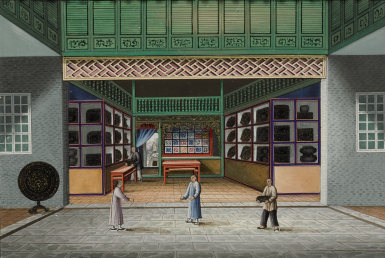
A RARE VIEW OF THE INTERIOR OF A LACQUERWARE SHOP QING DYNASTY, DAOGUANG PERIOD, 1820-40 | 清道光 1820-40年 廣東漆器店内貌 水彩紙本 鏡框
Auction Closed
January 25, 06:44 PM GMT
Estimate
6,000 - 8,000 USD
Lot Details
Description
A RARE VIEW OF THE INTERIOR OF A LACQUERWARE SHOP
QING DYNASTY, DAOGUANG PERIOD, 1820-40
清道光 1820-40年 廣東漆器店内貌 水彩紙本 鏡框
watercolor on paper, depicting a large circular gilt-decorated lacquer table to the left and further lacquer boxes, chests and trays on display shelves, one figure in the background supporting a circular lacquer box, with three further figures in the foreground, framed and glazed
Height 4½ in., 11.5 cm; width 6¾ in., 17.2 cm
The William B. Osgood Collection
Northeast Auctions, Portsmouth, New Hampshire, August 20, 1995, lot 556
Carl L. Crossman, The China Trade: Export Paintings, Furniture, Silver and Other Objects, Princeton, NJ, 1971, p. 168, pl. 138
Carl L. Crossman, The Decorative Arts of The China Trade, Suffolk, 1991, p. 265, pl. 98
This interior view of a lacquer shop, probably on New or Old China Street, is a rare record of the lively Chinese export lacquer market in the early 19th century in Canton (Guangdong). According to Carl L. Crossman, The Decorative Arts of The China Trade, Suffolk, 1991, p. 263, Japanese lacquers were usually preferred over Chinese lacquer wares, and Cantonese lacquers were considered inferior to lacquers produced in other Chinese cities, such as Nanjing. However, as described in Crossman, op. cit., Osmond Tiffany documented in 1849 that Cantonese lacquer decoration as painstaking and skillful. Chinese export lacquers were most often modeled after European designs, as evident in the gilt-lacquered tilt-top tea table shown on the left of the present example.
China trade paintings of shopfront scenes were most likely produced in series, such as two examples in the collection of the Victoria and Albert Museum, given by Mrs. Mary A. Goodman, and illustrated in Craig Clunas, Chinese Export Watercolours, London, 1984, p. 21, cat. nos. 3 and 4. One shop remains unidentified, as a large portion of the sheet was trimmed. The author speculates that the shop could either be a restaurant or an oil painting shop. The other painting depicts a tobacco shop, as evident by the large shop sign which reads Yanlin, or 'Tobacco Grove'. The author points to the unique execution of details in the painting such as the brickwork and paving, use of western perspective, and prominent use of apple green as signs that a not yet identified workshop was responsible for these examples. Other examples of shopfront paintings from the HSBC collection were exhibited and illustrated in Picturing Cathay: Maritime and Cultural Images of the China Trade, University Museum and Art Gallery, The University of Hong Kong, Hong Kong, 2002, cat. nos. 80, 81 and 87, including a poulterer, fishmonger and bamboo basket shop respectively.
